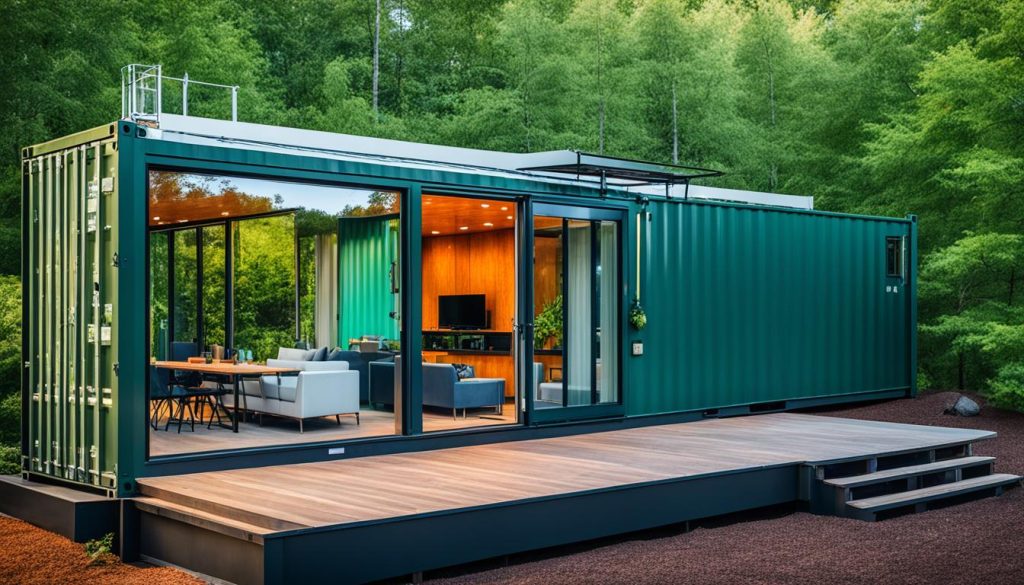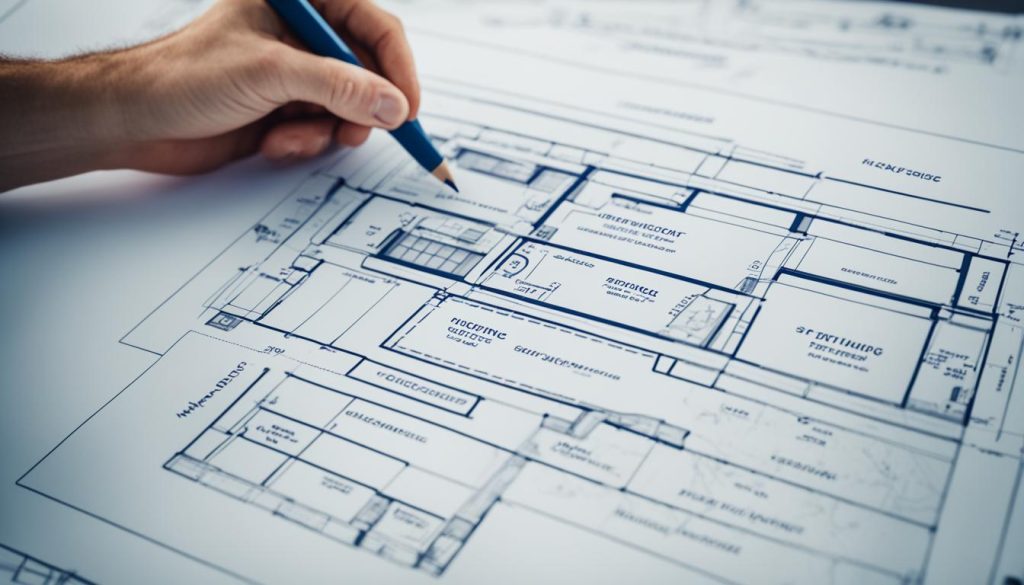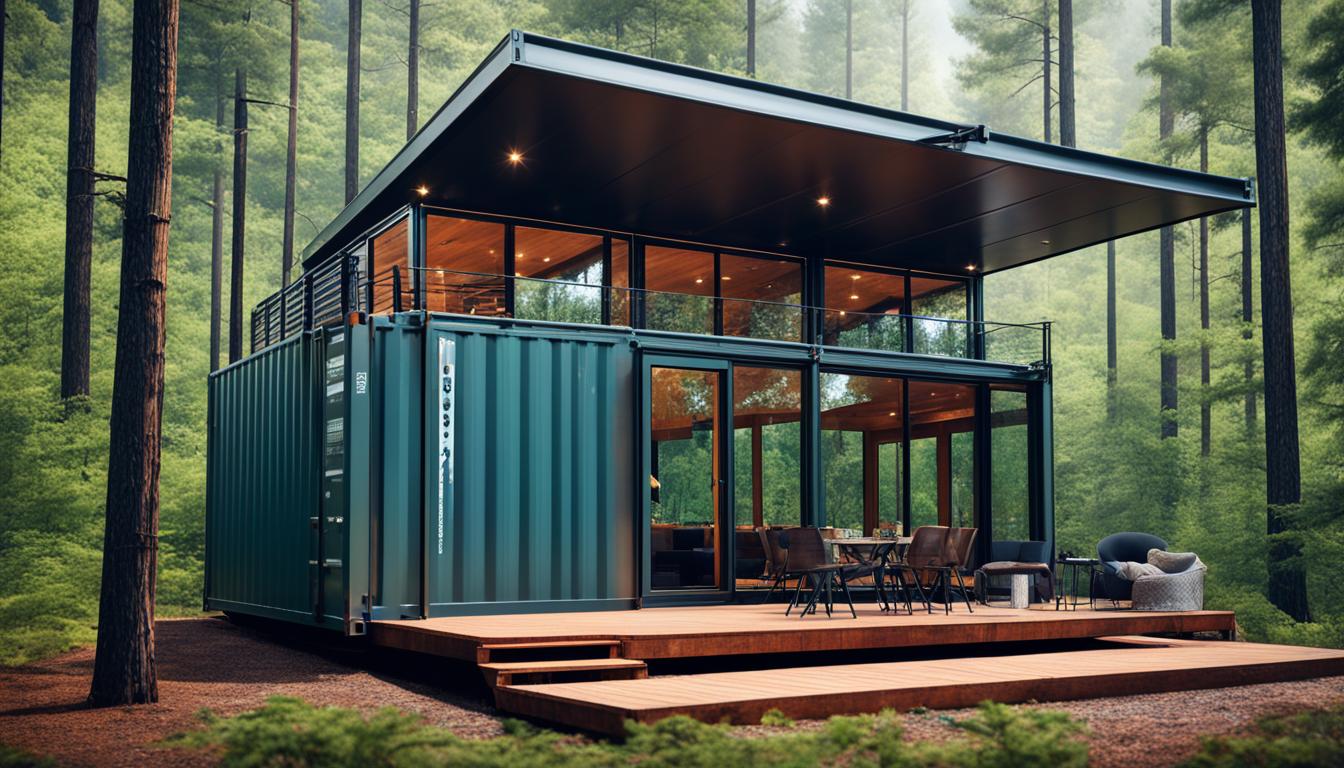Housing costs keep going up, and more people want to live sustainably. Building a shipping container house is a great idea. It’s affordable and good for the planet. I’m excited to share how I made my dream shipping container home. We’ll look at cost-saving tips and design ideas for shipping container houses, container home design, and affordable housing solutions.
Using eco-friendly construction and sustainable architecture, I found out how shipping containers can be turned into modular living spaces. These spaces can fit any lifestyle. If you like the idea of off-grid living options or just want a unique and affordable home, shipping container homes are worth checking out.
I’ll share tips on planning and preparing for your project. We’ll talk about picking the right recycled building materials and making the most of these sustainable structures. Let’s dive into the tiny house movement and see how shipping container homes are changing the way we think about alternative housing in the U.S.
Introduction to Shipping Container Homes

Imagine a home that’s strong and modern. That’s what a shipping container home is all about. These homes use steel shipping containers. They offer many benefits for those who live in them.
What is a Shipping Container Home?
A shipping container home is made from steel shipping containers. These containers were meant for carrying goods across the world. Now, they’re turned into homes that can be arranged in many ways.
Benefits of Shipping Container Homes
Shipping container homes have lots of perks. They are:
- Cost-effective: Containers are easy to find and cheaper than new building materials. This makes them a budget-friendly choice.
- Durable: Steel containers are tough. They can handle a lot, making them a solid base for a home.
- Customizable: You can change these containers to fit your needs. Add windows, doors, and more to make it your own.
- Sustainable: Using old containers cuts down on waste. It’s a green way to build a home.
- Modular: These homes are easy to move and put together. They’re flexible and can be set up in different places.
Shipping container homes are a hit because they’re affordable, strong, and good for the planet. They offer a unique and cost-effective way to live.
Planning and Preparation

Starting your shipping container home journey needs careful planning and prep. First, get the needed permits and approvals from local authorities. Work with architects, engineers, and inspectors to make sure your design follows all rules.
Obtaining Necessary Permits and Approvals
You must get the right permits and approvals before building your shipping container home. This means submitting plans, getting zoning okay, and following rules about using shipping containers for homes. Work closely with local authorities to make this process smooth and avoid delays.
Designing Your Shipping Container Home
The design phase lets you get creative and make your home special. Work with architects and designers to customize your home’s layout, size, and features. You can choose everything from windows and doors to finishes and amenities to make it your own.
Think about engineering aspects like strength, insulation, and how to connect utilities during planning. This ensures your home looks good, works well, is safe, and saves energy.
| Key Considerations in Shipping Container Home Planning |
|---|
|
Choosing the Right Shipping Container

Choosing the right shipping container is key for a successful home project. It affects the cost, design, and how easy the project is. You can pick between used or new containers, each with its own pros and cons.
Used containers are cheaper but need more work to get ready. New containers are a blank slate, making them easier to customize and build with. The size, like the standard 20-foot or 40-foot, affects the home’s layout and space.
It’s important to check the container’s condition before buying. Look for any damage, rust, or structural issues. Also, plan the delivery carefully to make sure it goes smoothly.
Comparing Used and New Shipping Containers
| Feature | Used Containers | New Containers |
|---|---|---|
| Cost | Generally more affordable | Typically more expensive |
| Condition | May require more refurbishment | Pristine condition, ready for customization |
| Customization | Limited due to previous modifications | Greater flexibility for customization |
| Transportation | Potentially more complex logistics | Simpler delivery process |
The choice between used or new containers depends on your budget, design likes, and project needs. Think about these factors to make a good choice for your shipping container home.
Site Preparation and Foundation
Building a shipping container home needs careful site prep and a strong foundation. First, pick the perfect spot that’s easy to get to, has utility lines, and good land. This choice is key for your project’s success.
Selecting the Ideal Location
Think about these things when picking a spot for your shipping container home:
- Accessibility: Make sure the site is easy to get to by car. This makes moving stuff in easier.
- Utilities: Check if there’s electricity, water, and sewage nearby. This makes setting up easier.
- Land Suitability: Look at the land’s shape and soil to see if it’s right for your home’s foundation.
- Zoning and Regulations: Make sure your site follows all local rules and building codes.
Foundation Options for Shipping Container Homes
There are different foundations for shipping container homes, based on the site and what you want. Here are some common ones:
- Concrete Piers or Basement: A concrete foundation is strong and lasts a long time for your home.
- Elevated Platform: An elevated platform can be made of wood or steel. It lifts the containers above the ground, solving problems with uneven land or floods.
- Wooden Supports: Wooden beams or posts can hold up the containers. This is a cheaper way to build a foundation.
The right foundation depends on the weather, soil, and building rules. Always talk to a pro engineer or architect to find the best one for your home.
Modifying the Shipping Container

Turning a shipping container into a cozy home needs careful changes. Cutting openings for windows and doors is a key step. This means cutting through the steel walls safely without weakening the container.
Cutting Openings for Windows and Doors
Where and how you cut affects the home’s air flow, light, and look. It’s wise to use experts for cutting and welding to avoid mistakes. These mistakes could make the container unsafe.
When adding windows and doors, keeping the container strong is key. The team must make sure the container can still hold weight and stay strong. They might add extra steel to support the openings.
The work to make these changes is complex and needs special skills. Planning and doing it right is crucial. This ensures the living space is safe and lasts a long time.
With the right structural thoughts and expert help, a shipping container can become a unique home. It can fit the owner’s needs and tastes perfectly.
Installing Doors, Windows, and Flooring
Turning a shipping container into a cozy home is all about the details. Doors, windows, and flooring are key. They make your home look good and feel comfortable and efficient.
Choosing the right doors and windows is important. You can pick from wood or metal frames that match your container’s steel walls. These let in light and air, helping keep your home cool or warm.
Flooring is also a big decision. You can choose from concrete, shipping container flooring, or wood. Each type has its own benefits, like being strong, insulating well, or looking nice. Think about your life, budget, and style to pick the best flooring for you.
Insulation is key for a cozy, efficient home. High-quality insulation, like spray foam or special container insulation, keeps your home comfy all year. It also cuts down on energy use.
| Feature | Benefits |
|---|---|
| Container home doors and windows |
|
| Flooring options |
|
| Insulation |
|
By picking and installing the right doors, windows, flooring, and insulation, you can make your shipping container home cozy, efficient, and stylish. It will show off your unique taste and needs.
The shipping container house: A Unique and Affordable Housing Solution
The demand for sustainable and affordable homes is growing. The shipping container house is a great option. It’s strong, eco-friendly, and can be customized to fit your needs.
Shipping container homes are very versatile. You can make them as small as a tiny house or as big as a multi-bedroom home. They let you live off the grid and support sustainable architecture.
Joining the shipping container home movement is exciting. It’s a chance to build a home that matches your values and dreams. This innovative housing solution is both affordable and unique.
Shipping container homes are popular among eco-conscious homeowners. They offer many ways to customize your space. This makes your home reflect your style and support sustainable living.
With a shipping container house, you can create a home that stands out. It’s a chance to be part of a movement towards better living spaces. This unique home offers endless possibilities.

